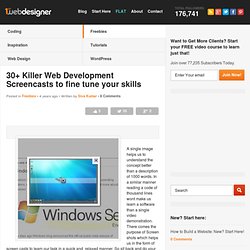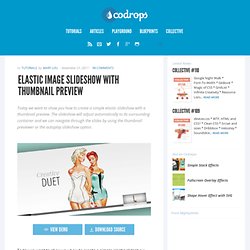

30+ Killer Web Development Screencasts to fine tune your skills. A single image helps us to understand the concept better than a description of 1000 words.

In a similar manner reading a code of thousand lines wont make us learn a software than a single video demonstration. There comes the purpose of Screen shots which helps us in the form of screen casts to learn our task in a quick and relaxed manner. So sit back and do your task in an effective manner.Updating the information on the site or developing the site as a whole is Web Development.
Targeting the specific users , a website is developed by planning, analyzing, designing and implementing the same. Then comes the promotion of the site which plays a major role and after promoting, thinking of novel ways to sustain in the industry. A screen cast gives you a much clear idea by its interactive way of explaining as similar to a live version with the help of a clear audio as in the case of Microsoft Office or Photoshop tutorials. 1.AJAX refreshing RSS content 2.Simple-Jquery-spy-effect Jquery:
Elastic Image Slideshow with Thumbnail Preview. Today we want to show you how to create a simple elastic slideshow with a thumbnail preview.

The slideshow will adjust automatically to its surrounding container and we can navigate through the slides by using the thumbnail previewer or the autoplay slideshow option. View demo Download source To make this slideshow responsive, we will use a mixture of JavaScript and CSS techniques. The fabulous photography used in the demo is by Bartek Lurka and it is licensed under the Attribution-NonCommercial-NoDerivs 3.0 Unported License.
So, let’s do it! The Markup We will create two unordered lists, one for the main slider and one for the thumbnail navigation beneath the large image. The list for the thumbnail preview navigation will contain an absolute element (the first list element with the class ei-slider-element and the thumbnail list elements which consist of an anchor and an image (the thumbnail). Now, let’s add the style. The CSS. 20 Powerful And Useful jQuery Tutorials Of Year 2011. A few days ago we created an awesome post featuring some of the great jQuery Animation tutorials which was appreaciated by our visitors those are in the professions of designing and developing.

This article clearly shows that how flash is getting out-dated and JavaScript frameworks are taking place when someone want to create animations. This article has also shown that jQuery is becoming favorite for many web developers and designers out there and using this JavaScript framework for creating stylish animations for websites, web apps, stylish effects and much more. Being one of the most advanced, powerful and lightweight JavaScript framework – we here at WebTabLab like jQuery very much and always love to showcase various compilations related to jQuery such as best jQuery plugins of May 2011, great jQuery plugins of July 2011 and recently jQuery animation tutorials. Don’t forget to subscribe to our RSS-feed and follow us on Twitter for recent updates. 1) Rotating Image Slider.
Gain A Better Understanding of jQuery. I've run into dozens of designers who aren't fully clear on what jQuery is.

They know it's cool, they know it's useful, and they may have even followed some related tutorials, but they're confused about what it really is. Is it something that comes with a browser? Is it a way of writing code? Is it a replacement for Flash? Is it just old-fashioned black magic? If you're a member of this group, this article is for you. To understand how jQuery fits into the landscape of the web, we have to first talk about JavaScript. jQuery's Roots: A Brief History of JavaScript An important word of clarification: Java and JavaScript are completely unrelated.
Back in the day in the mid 1990s, websites were painfully static. This all changed in late 1995, when Netscape created a new programming language called JavaScript and added it to the Netscape browser. Before developers could start using JavaScript, though, it had to become a standard. Fast-forward to 2005.